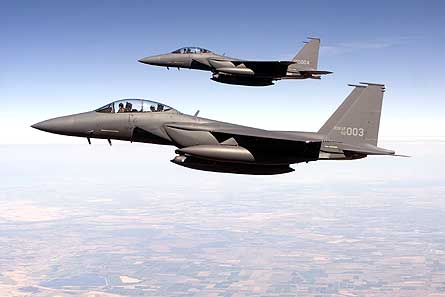By Brendan Sobie in Singapore
One of South Korea’s four new Boeing F-15Ks crashed last night during an overwater training flight.
The fighter went missing at twilight and rescue crews have already found remains of both the student pilot and instructor, who were believed to be wearing night vision goggles for the three-ship training exercise and did not eject. Some debris also has been discovered but the black box and major components, including the General Electric F110-129 engines, still remain underwater around 48km (30miles) off the South Korean coast.
Boeing says it is assisting the Korean air force in an investigation. The air force says its F-15K acceptance schedule will not be impacted unless the investigation, expected to take up to 90 days, uncovers a technical problem with the aircraft.
Industry sources say there are no indications there were any malfunctions and the cause of the crash was most likely pilot error given the unconfirmed early accounts of the other pilots believed to be involved in the training exercise. Sources believe the air force has a video of the exercise.
|
|---|
GE and other F-15K programme partners are monitoring the investigation closely because the aircraft which crashed was only the fifth F-15K to roll off Boeing’s St Louis production line and South Korea is the launch customer for the F110-129 engine on the F-15. Two Korean F-15Ks are pictured flying in formation above. Singapore, which late last year placed orders for 12 F110-powered F-15s, is also expected to monitor developments closely.
Boeing says it is still preparing to deliver later this month two more F-15Ks, which arrived in country earlier this week. Korea received late last year its first four F-15Ks – aircraft number three to six because the first two F-15Ks remain in St Louis for additional configuration testing – from its original 40-aicraft order
Seoul is planning to sign a contract for another 20 F-15Ks next year, but if a technical problem is discovered with the aircraft or engine it may reconsider the acquisition and delay initial operating capability, slated for next year.
Source: Flight International




















